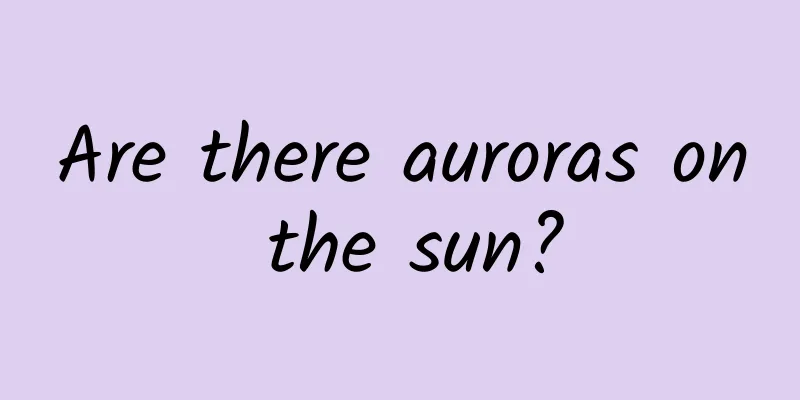Are there auroras on the sun?

|
Hello everyone, my name is Zhou Xuzhi, from the Institute of Space Physics and Applied Technology, Peking University. Today, I answered a scientific question in class, and was slapped in the face. So now I am very unwilling to accept it, but I think this question is actually quite valuable, so I want to review it here through this video. This question is very short: Are there auroras on the sun? I am quite familiar with the concept of auroras, so I will talk about it. I said, let's start with the auroras on Earth. When high-energy charged particles in space enter the Earth's polar atmosphere along magnetic field lines, neutral particles in the atmosphere, mainly oxygen and nitrogen atoms or molecules, will be bombarded to a relatively high energy state. Then when they jump back to the ground state from these high energy states, they will emit photons of specific wavelengths, which correspond to several specific spectral lines in the Earth's aurora, or in layman's terms, several different colors, the strongest of which are green and red (Figure 1). Figure 1: The colors of Earth's auroras Of course, other planets can also have auroras. For example, Jupiter. The main component of Jupiter's atmosphere is hydrogen, so the strongest in Jupiter's auroras are some characteristic spectral lines of hydrogen, such as the Lyman-alpha line in the ultraviolet band. But what about the sun? What happens on the sun is actually the opposite - there are some dark lines in the solar spectrum (Figure 2). This spectrum is called an absorption spectrum, and it is produced because the sunlight itself is very strong. When these photons pass through the upper atmosphere of the sun, if the frequency matches the spectral line of a specific element, they will be absorbed and form dark lines. Can this be called an aurora? I don't think so. Figure 2: Solar absorption spectrum Unexpectedly, this classmate came prepared. He showed me a report titled "Scientists discover a phenomenon similar to the Earth's aurora on the surface of the sun for the first time", citing a paper published in Nature Astronomy in November 2023, which is the top journal in the field of astronomy, Nature Astronomy, saying that auroras were found near sunspots, and the frequency was thousands of times stronger than the Earth's aurora. I was instantly confused. The frequency of the Earth's aurora is roughly in the visible light range. If the frequency is thousands of times higher than that of the Earth's aurora, it should belong to X-rays. Is this article about the solar soft X-ray burst? Of course, solar flares do emit soft X-rays, but this is not a new discovery, and it can't be called an aurora. So I can only tell that classmate very frankly that I don't know, let me go home and look through this paper. When I got home, I found out that this paper was actually talking about radio radiation. Radio waves are a type of electromagnetic wave with a very long wavelength. The wavelength of visible light that we usually mention is about a few hundred nanometers. For example, the red light in the aurora has a wavelength of 630 nanometers. But how long is the wavelength of radio waves? For example, we sometimes observe a type of radio radiation called the Earth's aurora kilometer wave. As the name suggests, the wavelength is about the order of kilometers, which is billions of times longer than visible light. Speaking of aurora kilometer waves, I would like to show you a very famous observation picture from the star scientist Carl Sagan. As you know, Carl Sagan has always had a strong interest in extraterrestrial life. So one time, he thought, maybe we can observe the earth from the perspective of aliens? Because humans use various electromagnetic waves every day, he wanted to see what electromagnetic waves could be seen if satellites in space were used to observe the earth, so that we would have a reference when searching for aliens (Figure 3). He used a satellite called Galileo and indeed observed electromagnetic waves from human activities. These horizontal bars in the upper left corner of the picture are. But in addition to this, we can also see many different electromagnetic waves, such as some scattered waves in the lower left corner, marked as AKR in the picture. This AKR stands for Auroral Kilometric Radiation, which is also known as the aurora kilometric wave. Figure 3: Satellite observation of the Earth's electromagnetic waves, from Sagan et al., Nature, 1993 From this picture, it seems that the auroral kilometer waves are not very conspicuous, but in fact, once they were discovered, they immediately attracted strong attention from scientists. Because it has several very special properties. First of all, this wave is very strong. How strong is it? If the observed radio radiation is regarded as black body radiation and the Planck formula is used to fit it, the corresponding equivalent temperature is about 10 to the 14th power. This temperature is too outrageous, so it is obvious that they are not derived from thermal radiation. Another property is more interesting. As we all know, if an electron is placed in a magnetic field, it will move around the magnetic field. The frequency of this movement is called the electron cyclotron frequency. People have found that the electron cyclotron frequency in the magnetic field of the Earth's polar regions is very close to the frequency of the auroral kilometer waves. In addition, the auroral kilometer waves, as the name suggests, are excited in the high-latitude auroral region of the Earth, and the propagation direction is basically perpendicular to the direction of the magnetic field. So it can be imagined that the excitation of this wave should be related to the cyclotron motion of electrons around the magnetic field in the high altitude of the polar regions, but there is still some debate about the specific excitation process. The current mainstream view is that this fluctuation is excited by a process called electron cyclotron maser instability. This instability sounds complicated, and of course it is, but we can give a simplified version. Imagine that there is a very weak electromagnetic fluctuation, and its polarization direction and frequency are consistent with the cyclotron direction and frequency of a certain electron. Then from the observation point of view of this electron, the electric field of this fluctuation always has a fixed phase difference with itself. So this electron can be continuously accelerated or decelerated, or in other words, the resonance between this wave and the electron leads to a strong energy exchange. Of course, there are many electrons in space, some of which give energy to the wave, and some of which give energy to the electron. If the former is more, then the electromagnetic wave will become stronger and stronger until it can be observed as an auroral kilometer wave. But there is a problem here. If the electron velocity distribution in space satisfies the Boltzmann distribution, and the number of electrons moving in each direction is the same, then the number of electrons that can give energy to electromagnetic waves is less than the number of electrons that obtain energy from electromagnetic waves. So in this case, the aurora kilometer wave will not appear. But the universe is so magical. Above the high latitudes of the earth, the number of electrons moving in different directions is different. This reason is directly related to the aurora. We just mentioned that the earth's aurora is mainly caused by electrons in space reaching the polar atmosphere along the magnetic field lines. So if you consider an electron in space, its direction of movement has a relatively large angle with the magnetic field lines, how will it move? It will be bounced back by the strong magnetic field at a certain height (Figure 4). In other words, only those electrons that bombard the earth's atmosphere will not be bounced back. So if you look at it from above the earth's polar regions, you will find that electrons may move in any direction, except for one direction - that is, against the direction of the magnetic field lines, almost no electrons will move in this direction. This anisotropic electron velocity distribution will lead to electron cyclotron maser instability, thereby generating aurora kilometer waves. This is why we name this radio radiation after the Aurora even though its wavelength is billions of times longer than the Aurora we usually talk about. Figure 4: Example of electron motion in the Earth's magnetic field Similar radio emissions can also be seen on other planets, such as Jupiter and Saturn. Of course, their frequencies are somewhat different from the auroral kilometer waves on Earth. The reason is simple, as mentioned earlier, the frequency of the auroral kilometer waves is very close to the cyclotron frequency of electrons, which is determined by the local magnetic field. Because Jupiter's magnetic field is much stronger than that of the Earth, the corresponding radio emission frequency is also higher than that of the Earth. In fact, the first measurement of Jupiter's magnetic field in human history was obtained by this method, using the frequency of Jupiter's radio emission to invert. Even on some low-mass stars, people have observed similar radio emissions, and it is generally believed that this radio emission also comes from the same source. Finally, let's go back to the sun. The novelty of this paper published in Nature Astronomy is that they observed similar radio radiation on the sun, which lasted much longer than the solar radio bursts usually seen, and occurred above sunspots. This process can be represented by a schematic diagram of the author (Figure 5). The two black areas at the bottom of the figure represent two sunspots. The magnetic field at the sunspot is very strong. It can also be seen from the figure that the magnetic field lines connecting the two sunspots are arc-shaped, and the magnetic fields at both ends of the magnetic field lines are stronger and the central magnetic field is weaker. This shape is also somewhat similar to the shape of magnetic field lines connecting the north and south poles of the earth. So the author made an analogy and believed that above the sunspots, there would be more electrons moving perpendicular to the magnetic field lines rather than parallel to the magnetic field lines, which led to the occurrence of electron cyclotron maser instability, thereby stimulating radio radiation. Because the magnetic field intensity above the sunspot is much stronger than that of the Earth's polar regions, the corresponding radiation frequency is also thousands of times higher than the Earth's aurora kilometer wave. Figure 5: Schematic diagram of the solar "Aurora" radio radiation I think this is a very interesting discovery, especially because they have proposed a new possibility. In the past, when people observed radio signals from some low-mass stars, they generally believed that these radio fluctuations came from the global magnetic field of the stars. But now we know that there is another explanation. Perhaps there are sunspots on these stars, and the small-scale magnetic field patterns between the sunspots can also stimulate radio radiation? This conjecture needs further research to test. Finally, let's get back to the point. Can this radio radiation from the sun be called an aurora? Maybe, but although there is some causal relationship between this so-called aurora in the radio band and the aurora we usually talk about, they are still very different after all. Maybe we should be more cautious when doing science popularization and not simply confuse the two? This is also the original intention of making this video, and I hope everyone can learn something from it. Thank you! This article is a work supported by Science Popularization China Starry Sky Project Author: Zhou Xuzhi, Researcher at the School of Earth and Space Sciences, Peking University Reviewer: Sun Zhibin, Researcher, National Space Science Center, Chinese Academy of Sciences Produced by: China Association for Science and Technology Department of Science Popularization Producer: China Science and Technology Press Co., Ltd., Beijing Zhongke Xinghe Culture Media Co., Ltd. |
<<: Is freeze-dried fruit really a waste of money? In fact, everyone has wronged it...
Recommend
Doctor Strange's wizard circle is not easy to mix with. Harry Potter plays a corpse to make a living.
In November, in addition to many shopping maniacs...
Consumption of 10,000, but conversion rate is less than 0.008! How to analyze and optimize accounts?
Today, I would like to share with you a case stud...
This is the truth behind Microsoft skipping Windows 9
Recently, Microsoft introduced and provided a pre...
What are the equipment that can be connected to the real-name system on construction sites?
At present, the country is vigorously promoting t...
Tips for optimizing information flow APP delivery!
In the actual delivery, how do we find the proble...
Take a bite of the pagoda vegetable and the fractal secret behind it is...
As the weather warms up, I put away my thick cott...
Inquiry on the investment price of Bozhou Moving Mini Program. How much is the investment price of Bozhou Moving Mini Program?
Starting a business requires costs, and mini prog...
Microsoft explains iOS app porting project: Sandbox-free access to Win10 API
Currently, Microsoft's Android application po...
Find the perfect platform 8 APP testing solutions
Testing applications is very cumbersome. Where ca...
How to analyze the 4 characteristics of online hot spots through user psychology
With the Internet so developed today, every hot s...
Professional Editor - Master Class
Professional Editor-Master Class Xuelang Resource...
Stock fund financial management course teaching stock market index fixed investment entry skills value investment novice tutorial complete set
From entry level to mastery, it is guaranteed to ...
Milky white, yellow, green... I have a cold, why are the snots different colors?
Whenever we have a cold, we usually have a sympto...
The antigen T region is particularly red. Is it related to the severity of the disease? Expert response →
"Everyone says that the redness of my T-zone...
Xu Jiaxi from Unicorn Think Tank: In-depth report on the ventilator industry
Source: Unicorn Think Tank Source: Industrial Sec...









